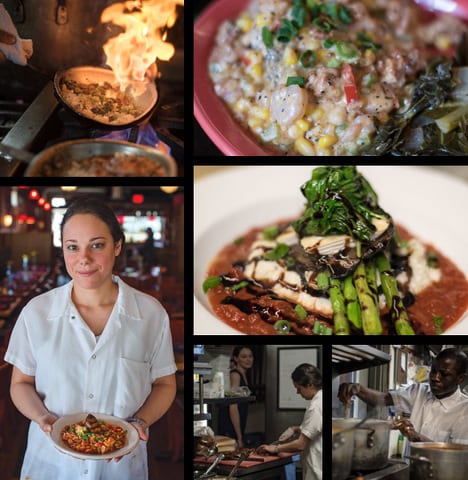
Taste of the Month: Spats Café and Speakeasy

At Spats Café and Speakeasy, take a full-flavored culinary journey through Louisiana’s Cajun and Creole cooking — a fusion of world cuisines from Spanish, French, and South American to Portuguese, German, and Cuban.
When it first opened in 1987, Spats Café and Speakeasy was true to the theme of a Prohibition-style eatery where the undeniable allure was the idea of a secret hideaway where the door was locked, and to gain entry, one would knock and utter the password.
“Male servers were in tuxedos, female servers in flapper dresses, and everyone was trained to do the Charleston dance when a guest buys a bottle of champagne. There was entertainment five nights a week, and the menu featured a lot of seafood and steaks,” owner Duke Gastiger explains.
The origin of the term “speakeasy” refers to the practice of speaking quietly about such a place in public, or when inside it, so as not to alert the police or neighbors during the Prohibition years from 1920 to 1933.
Over the years, Spats, located at 142 East College Avenue in State College, has evolved, becoming the best kept secret in town for traditional Cajun and Creole dishes and utilizing as much local, seasonal ingredients as possible. Although Spat’s takes walk-ins and guests are always welcome to sit at the full-service bar when dining tables aren’t available, it’s highly recommended for diners to make reservations for lunch and dinner Monday through Saturday.
The French-Canadians who settled in Acadia, just West of New Orleans in bayou country, became known as Cajuns. Cajun food is famous for being very well seasoned, which is sometimes misunderstood as spicy. Most dishes begin with a medley of vegetables based on the French mirepoix, but the holy trinity of Cajun cuisine utilizes onion, celery, and bell pepper (rather than carrots) to provide a flavor base for many dishes.
Creoles consist of the descendants of the French and Spanish living in New Orleans. Over the years the term “Creole” grew to include native-born slaves of African descent as well as free people of color. Typically, the term “French Creole” describes someone of European ancestry born in the colony, and the term “Louisiana Creole” describes someone of mixed racial ancestry.
Spats Café and Speakeasy’s chefs Justin Berkebile and Brittany Pereda are both culinary school graduates whose passion for food and knowledge of multicultural cuisines allow for a perfect blending of flavors that is unique to the Cajun and Creole culture in Louisiana.
“What makes Spats stand out is the quality of ingredients and the chance to work with unique items,” says Berkebile. “My favorite dishes at Spats that people should try are the crispy skin duck breast with port wine glaze, Jamison lamb rack, beef short ribs, and sweet potato catfish.”
Pereda adds, “As a Cuban American, Spats Café offers food that reminds me of home and the food my grandmother made when I was young. I recommend the Voodoo shrimp and grits, the catfish, the Portobello Napoleon stack, and, for dessert, the gluten-free chocolate cake — it melts in your mouth!”
Other popular items include the Creole jambalaya, the pasta with crab and crawfish, creamy corn chicken, and gator bites.
“Lagniappe is a word in the south that means a little something extra either before or after the meal,” says Gastiger. “At Spat’s, we like to give our guests a little surprise, whether it’s an ingredient they don’t expect, like crawfish, a little pecan bread, or an amuse-bouches, which is a gratis, single, bite-sized hors d’oeuvre, as a thank you for making reservations with us.”
In between courses, small fresh-made sorbets are offered as a palate cleanser. It is traditionally served between the appetizer or salad courses and entrée.
“It will get your mouth ready for all the entrée flavors, so you start with a blank slate,” says Gastiger. “The idea is to have a touch of sweetness, but not overpowering, so we have made green tea, apricot, kiwi, Meyer lemon, basil, and other herb sorbets.”
Spats menu changes seasonally and every week, depending on what fresh seafood is brought in Thursday morning. A special weekly menu is introduced every Thursday, Friday, and Saturday. A new menu comes out in May that will include bison, American wagyu steak, lighter sauces, and dishes that highlight the local bounty.
Gastiger is passionate about sustainable practices, responsible food sourcing, and energy-reduction strategies. The next step in incorporating these practices at Spats Café is his plans for a RE Farm Café, a groundbreaking farm-to-fork restaurant and sustainable grange scheduled to be operational next year. It will be a 58-seat restaurant that will be open only March 21 to December 21 (Wednesday to Saturday for dinner and Saturday brunch).
“I have been working on it for five years, and my wife, Monica, and I ended up buying a 57-acre farm on Filmore Road close to the airport. We put up a quarter-acre greenhouse to grow seeds, greens, and herbs for Spats Café and for RE Farm Café,” Gastiger explains.
RE Farm Café is poised to be the first restaurant internationally to meet the requirements of the Living Building Challenge, or LBC. That means RE Farm Café will need to be net-zero water, net-zero energy, and composed of chemical-free, reclaimed, and locally sourced materials. LBC also asks that buildings are community-focused centers for education, in order to teach about sustainability, equality, and our relationship to nature.
“We will be working with local chefs to do cooking classes and teaching people how to cook with local foods without trying to mask the flavors,” says Gastiger.
RE Farm Café will have ultra-efficient building systems and on-site solar renewable energy production. The kitchen will contain induction-cooking equipment that uses electromagnetic direct-heat transfer, minimizing energy consumption and waste heat. It also will use LED lighting, natural ventilation, and root-cellar food storage.
“Ultimately, we will have chickens, sheep, goats, ducks, and turkeys on the farm,” Gastiger explains. “We have tapped over 200 trees for maple, hickory, and black walnut syrups. And we have plans on planting fruit trees, and the idea is to bring that Heirloom quality to the menu.”
For more information about Spats Café and Speakeasy, visit spatscafe.com.
For more information about RE Farm Café, visit refarmcafe.com.
Recipe for smoked red snapper with maple pecan vinaigrette:
1 SNAPPER FILET (skin off). SEASONED WITH SALT AND PEPPER.
SMOKE AT 145 DEGREES FOR 1 HOUR THEN CHILL.
CHOP 1/2 CUP OF PECANS ROUGHLY.
1/2 CUP CIDER VINEGAR.
1 CUP MAPLE SYRUP.
2 TSP OF DIJON MUSTARD.
1 TBSP CHOPPED FRESH BASIL.
1 TSP CHOPPED PARSLEY.
1/2 TSP CHOPPED GARLIC.
1/2 CUP BLENDED OIL.
WHISK EVERYTHING EXCEPT THE OIL TOGETHER. ONCE INCORPORATED ADD OIL SLOWLY WHILE WHISKING UNTIL THE DRESSING COMES TOGETHER. ADD SALT AND PEPPER TO TASTE. Drizzle over snapper on greens, or asparagus, or any other favorite base.
______________________________________
TASTE OF THE MONTH – JULY ISSUE SUMMER COCKTAILS CONTEST
 Menu
Menu









 Instagram
Instagram  Youtube
Youtube